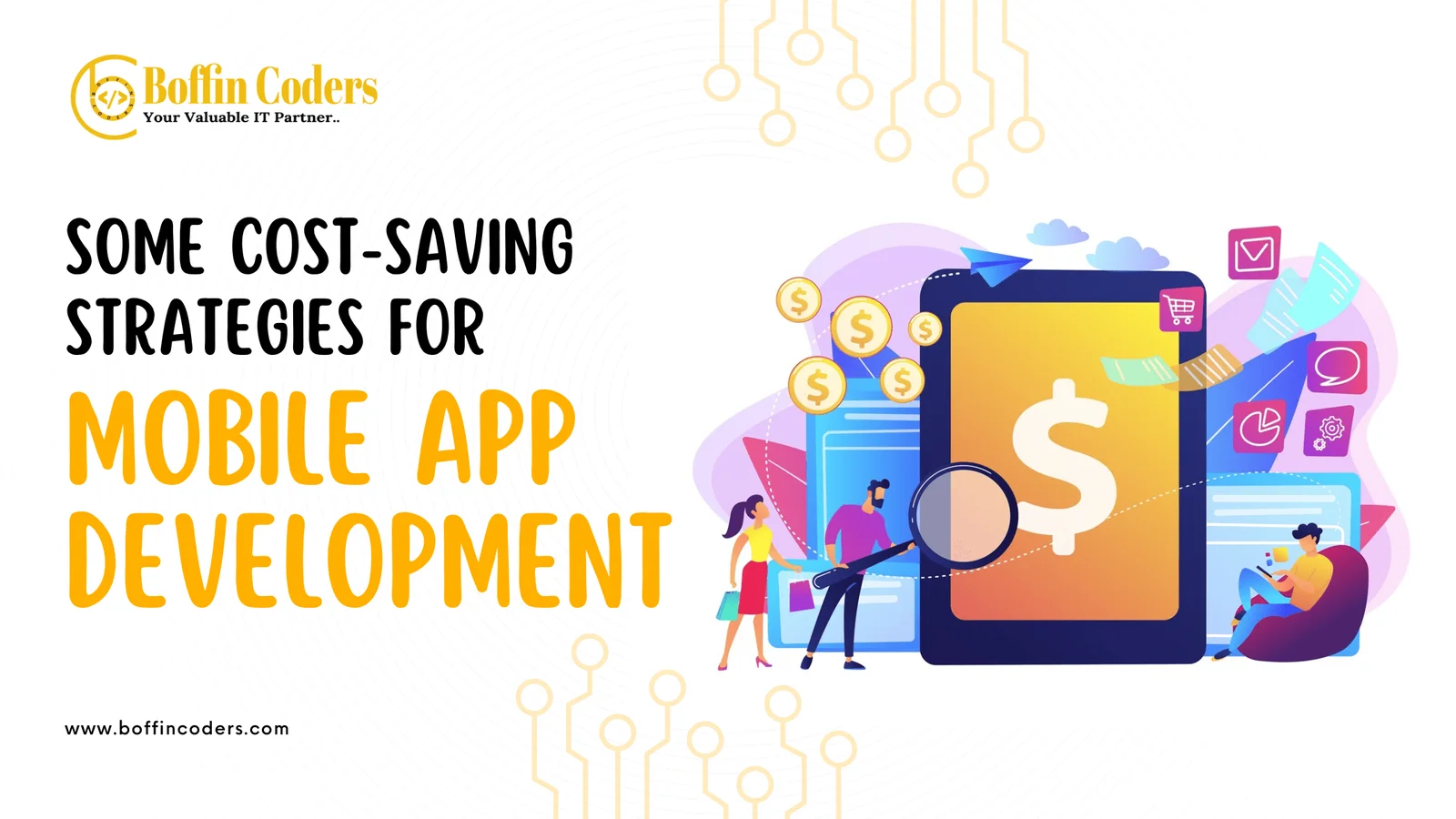Mobile app development is super important for businesses to grow and make their brand more valuable. Both small and big businesses want to create a perfect app. But making apps has become a way for developers to make money. Sometimes, though, the whole process of making an app can cost a lot.
Some developers or freelancers don’t always do things the best way when making apps. It’s really important to plan out the whole project and keep it under control. This way, you can figure out how much making the app will cost and manage your money better.
Let’s explore some smart cost-saving strategies that can help you navigate the world of mobile app development without burning a hole in your pocket.
Tips to Consider for Saving Mobile App Development Cost
1. Start with a Minimum Viable Product (MVP)
Instead of building a full-scale app right away, start with a minimum viable product (MVP). This is a simpler version that allows you to test your app concepts with minimal resources. It helps you gather feedback and make improvements before investing heavily in the complete version.
2. Cloud Services
Explore cloud services for hosting and data storage. Platforms like AWS, Azure, and Google Cloud offer scalable solutions. Allowing you to pay only for what you use. This eliminates the need for expensive infrastructure investments and provides flexibility as your app grows.
3. Outsourcing Mobile App Development
Mobile app development can help you make a great app. Having a team of developers with different skills can make app development cost more. When you outsource a mobile app development team, you bring together different skills and knowledge. This helps businesses benefit from a wider range of expertise among their team members.
4. Agile Development
Adopt an agile development approach. This means breaking down the project into smaller, more manageable parts. It allows for continuous improvement, making it easier to address issues early on. Regular feedback loops ensure that the final product aligns with user expectations.
5. Simplicity at its best for UI/UX
When it comes to the user interface (UI) and user experience (UX) of your app, simplicity is key. A clean and straightforward design not only enhances user satisfaction but also reduces development costs. Complex designs often require more time and resources to implement. By opting for a minimalist approach, you not only create a user-friendly experience but also keep your development budget in check.
Need expert assistance in developing your next mobile app? Why not partner with a top-tier mobile application development agency? Contact us now!
6. Consider Cross-Platform Development
Building separate apps for different platforms (iOS and Android) can be expensive. Think about utilizing cross-platform development tools such as React Native or Flutter. These frameworks allow developers to write code that works on both platforms, saving time and money. With a single codebase, you can reach a wider audience without doubling your development costs.
7. Optimize In-House Talent
Invest in a training program for your in-house team. Developing the skills of your existing team members can lead to a more efficient and cost-effective development process. Encouraging knowledge sharing and collaboration to enhance expertise within your organization.
Types of Mobile App Development
There are three main types of Mobile Applications:
1. Progressive Web Apps (PWAs)
PWAs are the rising stars of the mobile app scene, blurring the lines between websites and apps. Built with web technologies, they offer an app-like experience through features like offline access, push notifications, and home screen installation. Think of them as the comfy jeans of the app world, providing convenience and functionality without the bulk of a native app.
2. Hybrid Apps
Hybrid apps are the chameleons of the app world, blending native elements with web technologies like HTML, CSS, and JavaScript. This allows them to run on multiple platforms with a single codebase, making them more cost-effective and faster to develop than native apps. Think of them as versatile travel wardrobes, adapting to different platforms while retaining a familiar feel.
3. Native Apps
Native apps are the OG rockstars of the mobile world, built specifically for a single platform (iOS or Android) using their respective programming languages (Swift/Objective-C for iOS and Java/Kotlin for Android). This tailored approach gives them unbeatable performance, seamless integration with device features, and an overall smooth user experience. Think of them as the custom-designed suits of the app world, offering a perfect fit and top-notch functionality.
Mobile App Development Cost
The number of mobile phone users is driving significant spending on mobile applications, projected to reach nearly $171 billion globally in 2024. This trend makes it vital for businesses of all sizes to develop mobile applications for direct customer interaction.
The process of mobile app development involves various steps and stakeholders, depending on the project’s size and type. The costs of mobile apps vary based on factors such as app type, development platforms (Android, iOS, and Windows), number of pages, features, UI/UX, infrastructure, business model, native or hybrid nature, and third-party integrations.
Here’s a breakdown of the mobile app development costs in 2024:
1. Costs for Requirement Gathering and Planning
In the initial phase of every mobile app development process, planning takes center stage. The client presents their idea to the project manager, who analyzes it, gathers detailed requirements, and plans the project’s progression. The initial requirements need to be comprehensive for the mobile app’s prototyping. The budget for research, planning, and requirement gathering typically falls within the range of $1000 to $10k.
2. Design Phase Budget for Mobile Application
Moving forward, graphic designers are brought in to strategize and execute the website’s layout. The app design aims for attractiveness, intuitiveness, sophistication, and visual appeal. Design considerations align with the app’s type, emphasizing high-definition images and graphics. The cost associated with this phase varies between $1000 and $20,000.
3. Estimating App Development Costs
The most critical and time-consuming phase in creating a mobile app is the development cost estimation. This stage involves extensive coding and unit testing to ensure the code functions effectively and delivers the needed features to end-users.
Development can be handled by an internal team or assigned to external developers, particularly through outsourcing. The team size depends on the app’s features and overall size, making the development phase the most expensive in mobile app creation for various platforms.
➨ For individual freelance developers, costs range from $1000 to $10k.
➨ A small team of developers might require a budget of $10k to $100k.
➨ Middle-sized development firms could cost between $50k to $200k.
➨ Large companies offering mobile app development services may range from $100k to $500k.
Hourly Rates
For developers in India, hourly rates for iOS or Android app development vary from $15 to $100, depending on experience and skill level.
Most Common Risk in Mobile App Development in 2024
1. Building a Mobile App That is Not Useful for Users
One major risk is creating an app that doesn’t serve a real purpose for users. To overcome this, thorough market research and an understanding of user needs are crucial. Developing an app that solves a problem or fulfills a need will increase its chances of success.
2. Incorporating Too Many Features
While adding features might seem like a good idea, too many can overwhelm users. Focus on essential functionalities and prioritize a seamless user experience. Simplicity often leads to better user engagement.
3. No Unique Offering
With millions of apps available, standing out is essential. Ensure your app has a unique value proposition that distinguishes it from competitors. A distinctive feature or a novel approach can make your app more appealing to users.
4. Developing for Multiple Platforms at Once
Simultaneous development for various platforms can be challenging and resource-intensive. Consider launching on one platform first, gathering user feedback, and then expanding. This iterative approach helps in refining the app and optimizing for different platforms.
5. Bad UX/UI
User experience (UX) and user interface (UI) design are critical for an app’s success. A confusing or unattractive design can drive users away. Invest in creating an intuitive, visually appealing interface that enhances the overall user experience.
6. Security Threats
As cyber threats evolve, ensuring the security of user data is paramount. Regularly update your app’s security features, use encryption, and follow best practices to safeguard user information and maintain their trust.
7. Not Choosing the Right Mobile App Development Partner
Selecting the wrong development partner can lead to delays, cost overruns, and subpar results. Research potential partners thoroughly, check their previous work, and ensure they align with your project’s goals.
Final Opinion
In the competitive landscape of mobile app development, cost-saving strategies are vital for businesses aiming to maximize their return on investment. By defining clear objectives, embracing cross-platform development, utilizing open-source technologies, adopting Agile methodologies, considering outsourcing, and focusing on MVP development, businesses can optimize their mobile app development budgets without compromising quality.
For the best mobile app development experience, consider partnering with Boffin Coders. Our team of professional app developers is dedicated to delivering high-quality solutions tailored to your business needs. Hire mobile app developers at Boffin Coders for a seamless and cost-effective development journey!






